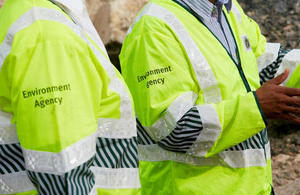
A successful bid for £700,000 means that more than 300,000 more trees will now be planted in the River Aire catchment area to help reduce flood risk.
The extra government funding has been awarded to Leeds City Council's Flood Alleviation Scheme (FAS) which includes natural flood management (NFM) as a major element to help protect the people of Leeds and those living near the River Aire from the risk of flooding. The Leeds FAS is led by Leeds Council working alongside the Environment Agency.
The bid, which will fund 333,333 trees, was made to the Partnership Innovation Fund (PIF), a programme managed by the Woodland Trust - a national charity - to enable the creation of new woodland in the Northern Forest through the planting of one million trees by 30th March 2022.
The Partnership Innovation Fund is part of a £5.7m grant awarded by Defra to the Woodland Trust in 2018 to help kick-start delivery of the Northern Forest in partnership with the four northern Community Forests.
The first few thousand trees in the Leeds City Council project were planted this winter past, a further 75,000 are planned by 31 March 2021 and 253,333 by the end of March 2022. At least 148 hectares of new woodland near the River Aire will be created through the project. When the tree planting starts it will be carried out in line with the latest government advice and guidelines on social distancing to ensure that members of the public and workers remain safe.
Holly Radcliffe, project manager with the Environment Agency for the Leeds FAS NFM programme, said:
We are delighted to receive this extra government funding. Our programme for the River Aire catchment and the Northern Forest are clearly connected and will not only provide greater opportunities for reducing flood risk but also have much wider environmental benefits alongside a positive impact on health and wellbeing.
"These trees will be planted on both public and private land and provide direct benefits to local communities living near the River Aire. We would like to work with local landowners who are willing to support the project by allowing us to plant trees on some of their land.
"Natural Flood Management also offers huge potential for climate mitigation, for example, creating wetlands, restoring our uplands and planting trees can help to capture tonnes of carbon from the atmosphere.
Leader of Leeds City Council, Councillor Judith Blake said:
This additional funding is very much welcome as tree planting is a key part of tackling the climate emergency. Planting of this scale has been proven to help reduce flood risk and can bring a wealth of other benefits such as storing carbon, better air quality and increased biodiversity.
"Natural Flood Management has a key part to play in protecting communities in Leeds that have previously suffered flooding from the River Aire, which is why we continue to call for the Government to provide funding so that phase two of the Leeds Flood Alleviation Scheme can be completed in full."
Nick Sellwood, Northern Forest Project Manager for the Woodland Trust said:
We very much welcome the huge ambition shown by Leeds City Council to take a truly catchment scale approach to natural flood management, recognising the important contribution trees and woodlands can make to this issue while at the same time improving biodiversity and tackling climate change.
The ambition of phase 2 of the Leeds Flood Alleviation Scheme is to work with natural processes to reduce flood risk across the catchment and so ultimately to provide increased resilience to climate change for Leeds.
A flagship Natural Flood Management (NFM) programme, alongside traditional engineering, forms part of the second phase of the Leeds Flood Alleviation Scheme. This phase got underway this year and aims to invest £112.1 million in flood prevention measures for areas upstream of Leeds city centre, to better protect 1,048 homes and 474 businesses. During this second phase two million trees will be planted.
The NFM element is transformational in scale working with nature to reduce the risk of flooding across the catchment from the source of the River Aire, at Malham, through to Leeds City Centre. The programme will not only reduce flow of water from upstream so the landscape can hold more water in times of flood but also restore and create new habitat, increase biodiversity resilience and improve water quality. As well as tree and hedge planting, it includes re-channelling rivers to their natural courses, soil aeration, wetland creation and moorland restoration all of which have lots of benefits for people and wildlife. This will contribute to delivering the Government's 25 Year Environment Plan and realising the vision of the Northern Forest in the Aire catchment.
F






